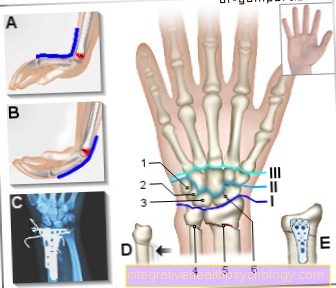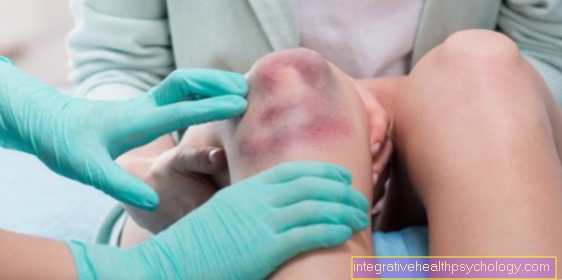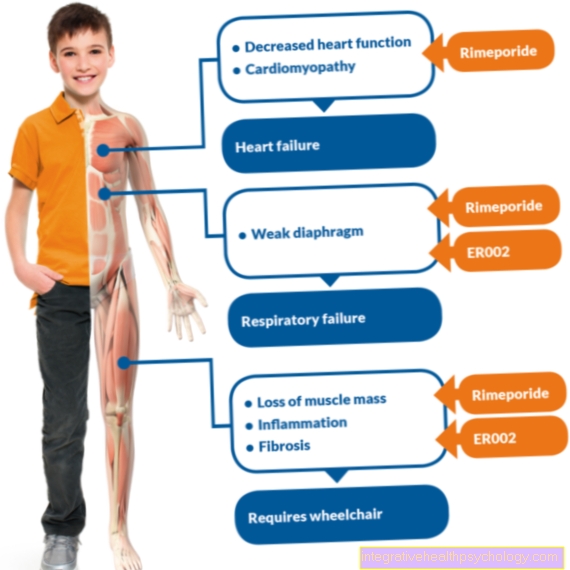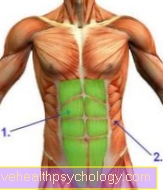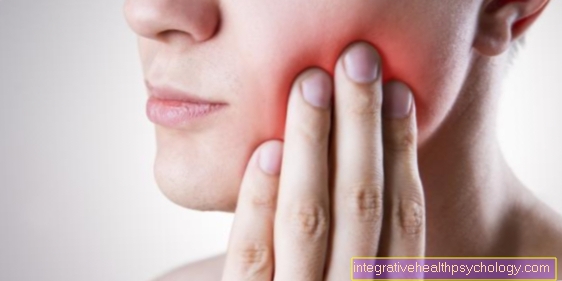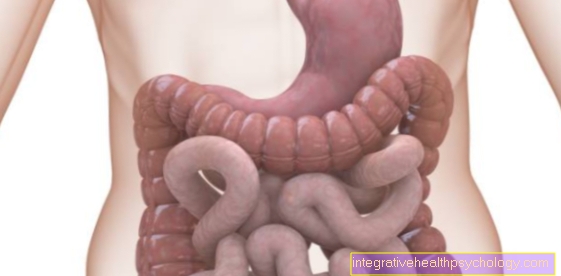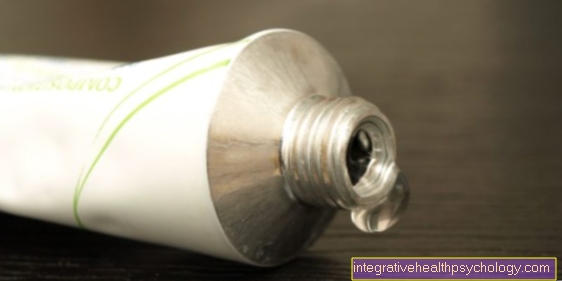Removal of fat on the thigh
introduction
Liposuction (technical term: Liposuction) is an aesthetic surgical procedure (“cosmetic operation”) in which fat cells are suctioned off at certain points under the skin. In general, aesthetic interventions are understood to be those that are carried out at the patient's request and that should lead to a change in the external shape.
It is a relatively new development in surgery that has only shown success since the late 20th century and has continued to develop since then. Liposuction is now a surgical measure that is used frequently.
Liposuction should only be used when stubborn fat deposits cannot be removed through a strict diet or intense physical activity. It is not used to treat obesity (obesity).
One should always keep in mind that an option also involves certain risks. You can also reduce the fat on the inside of the thigh or on the entire thigh without surgery. Read for this: How can I lose weight specifically on the inside of the thigh?
Causes of fat deposits
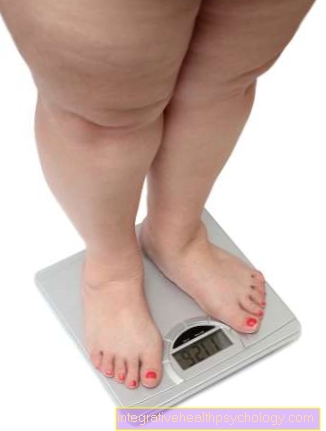
Excessive fat deposits can arise in a number of ways. Many people gain weight because of their lifestyle through unhealthy diet or disordered eating habits and lack of exercise. Many women have problems getting rid of excess fat and tightening the tissue again after pregnancy. With age, changes in metabolism and hormonal balance can lead to weight gain. In addition, genetic predisposition plays a role in the distribution of adipose tissue and in the tendency to weight problems. Endocrine diseases, i.e. diseases of the hormonal balance, such as resistance to certain hormones that are essential for lipid metabolism, also play an important role. Fat tissue is also deposited in the thighs with lipedema.
Certain medications (such as glucocorticoids or neuroleptics) can also cause weight gain. The abdomen, thighs, buttocks, hips and breasts are predisposed to annoying fat deposits.
A distinction is made between two different fat distribution patterns.
The android obesity corresponds to the male fat distribution pattern. The increase in weight occurs primarily in the area of the abdomen, i.e. around the abdomen ("abdominal or central obesity"). It is also popularly known as the "apple type".
The female fat distribution pattern is that gynoid obesity with emphasis on the hips and thighs, also called peripheral obesity or "pear type".
The quotient of waist and hip circumference is used to assign to one or the other type.
Epidemiology
In Germany, 250,000 people have fat suctioned off every year, in the US there are about 750,000. Men now make up a share of 20%.
Liposuction is one of the most frequently performed aesthetic surgical procedures, around one in five operations removes fat. It is often carried out in combination with other aesthetic surgical interventions, for example skin tightening, in order to optimize the cosmetic result.
procedure
Either outpatient as well as stationary can be operated on away fat. It depends on the extent of the operation. Local anesthesia can be used for minor operations. Here, the patient is placed in a sedated state, that is, he is given a tablet or an injection before the procedure, whereupon he falls into a state in which he is addressable but relaxed and insensitive to pain. After the operation, he can leave the clinic after a period of rest.
If a major operation is carried out in several places, the operation is usually performed under general anesthesia. The anesthetist (the anesthetist) is present during the entire operation and monitors the anesthesia. In the case of liposuction of the legs or hips, spinal anesthesia can be used instead of general anesthesia. A local anesthetic is injected into the spinal column, which blocks the sensitivity and motor skills of the lower half of the body.
During the operation itself, the fat cells are aspirated through small skin incisions about 0.5 - 1 cm long on the previously marked areas. If possible, the incisions are made in places where the remaining scars are not too noticeable. So that Result symmetrical the surgeon makes sure remove the same amount of fat on both sidesby collecting and measuring the extracted amount. The amount of subcutaneous fatty tissue removed varies greatly depending on the condition, but more than 5 liters are not removed in one session.
After the skin incisions have been sewn Bandages, support stockings or the like pulled over, to compress the tissue of the affected areas. This is to prevent excessive bleeding and subsequent bruising. The period in which the compression clothing should be worn can vary from a few days to a few weeks.
The duration of the procedure can be 20 minutes or up to three hours. Liposuction on the thighs or on the hips takes about 1 - 1.5 hours on average.
An infusion can be applied after the procedure, as water is withdrawn at the same time as the fat cells. This therefore serves to compensate for the loss of fluid. Since more fluid escapes from the tissue after the operation, a dressing must be changed regularly at the beginning.
Methods - fat away
There are several methods of liposuction. Originally the "Basic suction". It has been used since the late 1970s and it is from this that the other techniques have evolved. The Basic method is suitable for minor interventions, where the fat deposits are easily accessible. It will be per session maximum three liters Fat removed. It is cheaper than other methods because it does comparatively less complex is.
During the operation, a Fluid injected into the subcutaneous fat. This fluid causes the blood vessels to contract - which prevents bleeding - it also contains a local anesthetic and is supposed to prevent swelling. The surgeon inserts fine cannulas through small incisions in the skin, with which he loosens the fatty tissue and then uses a Vacuum pump sucks off together with the liquid. It can also manual suction syringes be used. This manual process is called liposculpture. According to proponents of this method, the weaker suction makes it more gentle on the tissue than mechanical suction. Then the skin incisions are sewn or glued.
A modification of the Basic method is the Tumescent technique. It is currently the most widely used. The difference to the basic method is that one is clear large amount of fluid injected into the tissue is, namely three times the volume of the fat to be removed. The tumescent liquid consists of a isotonic saline solution, one local narcotics, adrenaline to constrict blood vessels and Cortisonethat has an anti-inflammatory effect. The liquid causes the affected area of the body to remain numb for up to 18 hours, so that general anesthesia is usually no longer necessary. The fat cells soak up the mixture, which makes them easier to remove from the connective tissue. The Softened tissue swells strongly at the point, therefore the name (tumescere: Latin for swell). After an exposure time of 30 - 60 minutes, the mixture of fat cells and the liquid is sucked off by means of fine cannulas under suction of the vacuum pump or manually, as in the basic method. Veins, vessels and nerves are not injured because of the loosening of the tissue. In the case of the tumescence method, one session up to four liters of fat be taken away. Since the patient does not need general anesthesia, he can change position during the operation to ensure that the surgeon has good access to the affected areas.

A third method of liposuction is that "Super wet method". Here - contrary to what the name suggests - less fluid injected into the tissuethan with the tumescent technique. The ratio of liquid to the fat to be sucked off is about 1: 1. Because of the lower dose of anesthetic, the patient is put under general anesthesia. The procedure takes about two to three hoursduring which large amounts of fat - up to five liters - can be removed. Therefore, this technique is suitable for liposuction on the Thighs or on the stomach.
In the various methods, so-called microcannulas can be used instead of the conventional cannulas with a diameter of 3 - 8 mm. They have a diameter of only 1 - 2.5 mm, which enables more precise and tissue-conserving suction and which means that minimal skin incisions are sufficient.
There are also various modifications to the technique of liposuction. The suction is supported by various adapters on the cannulas. One distinguishes vibration-assisted, water-jet assisted, ultrasound and laser-assisted liposuction. The ultrasound is supposed to liquefy the fat cells before the suction, the laser is supposed to transfer heat energy into the tissue.
The liposuction must be of the so-called Lipolysis ("Fat dissolution"). Here, the fat cells are not completely removed - as is the case with liposuction - but only emptied. The tissue is supplied with external energy (e.g. ultrasound) or cold.
Furthermore one differentiates the Injection lipolysiswhich is only used for localized fat accumulations. A substance that is not approved for this use in Germany is injected into the tissue, which causes the fat cells under the skin to die. This method has been criticized for its possible side effects and is banned in some countries.
Fat away after-effects
After liposuction you need observation and Follow-up care by the attending physician. There are bruises, Swelling or severe pain, it should be available to assess wound healing.
Chances of success
An improvement through liposuction can only be seen when when the swelling has subsided. This usually takes about six weeks. Depending on the size of the procedure, the final result is only visible after several months.
Since the removed fat cells do not grow back, the fat deposits should be permanently removed. However, the few remaining fat cells can of course still store fat. In addition, if you gain weight again, a Redistribution of adipose tissue respectively. As a result of the increase in other parts of the body than before, new "problem areas" are formed, which may lead to greater cosmetic problems than before liposuction. In the case of liposuction on the thighs, for example increased fat stored in the arms become.
By redistributing it can also become one increased proportion of visceral fat come. The visceral fat accumulates in the abdominal cavity. As it increases, so does the risk of diabetes, heart disease and high blood pressure.
Therefore, sufficient discipline and effort on the part of the patient to maintain their weight after the operation is necessary.
The success of liposuction on the thighs to reduce cellulite ("orange peel") also depends on the additional measures taken by the patient - namely physical activity and a healthy diet (see: Exercises against cellulite). Whether liposuction can effectively remove cellulite is a matter of debate. In the long term, it can only be seen as a supportive measure.
Complications and risks
General risks like Infections, Thrombosis, allergies or a temporary numbness exist as with other operations also with liposuction. Complications that limit the outcome of the procedure, such as small dents, skin irregularities or asymmetries, may require follow-up treatment. A rare complication can be a State of shock after having sucked in too large amounts of fatty tissue. In patients with previous illnesses (e.g. diabetes) or smokers, wound healing may be delayed.
To prevent dents, bumps or sagging of the skin, the fat must be removed evenly and gently. A thin layer of fat must remain between the muscles and the skin, otherwise adhesions can occur. In addition, not too much fat should be operated on, otherwise the skin will be wrinkled without a subsequent tightening.
The above Take risks increased in the case of poor hygienee or, for example, incorrect thrombosis prophylaxis, as well as if risk factors such as heart failure, allergies or wound healing disorders of the patient are not taken into account.
Taste fat
The cost of liposuction will be Usually not covered by the health insurance, as they are usually carried out for purely aesthetic reasons. The prices for liposuction vary widely, roughly between 2000 and 7000 euros. Larger operations, especially on the abdomen or thighs, are among the most expensive.
Conclusion
Liposuction on the thigh or on other parts of the body to remove stubborn fat deposits or e.g. Getting rid of the so-called "saddlebags" is possible, should but because of the risks associated with the operation and the possible consequences such as the redistribution of body fat (see above) be the last resort. It should only be considered after prolonged efforts to reduce fat through diet and exercise. In the fight against cellulite, liposuction should at most be seen as a supportive measure, as it is controversial whether liposuction can really have a lasting effect on cellulite.
In any case, it is important to yourself to provide comprehensive information before the procedure and choose a reputable clinic that addresses the patient's individual risks and circumstances.






